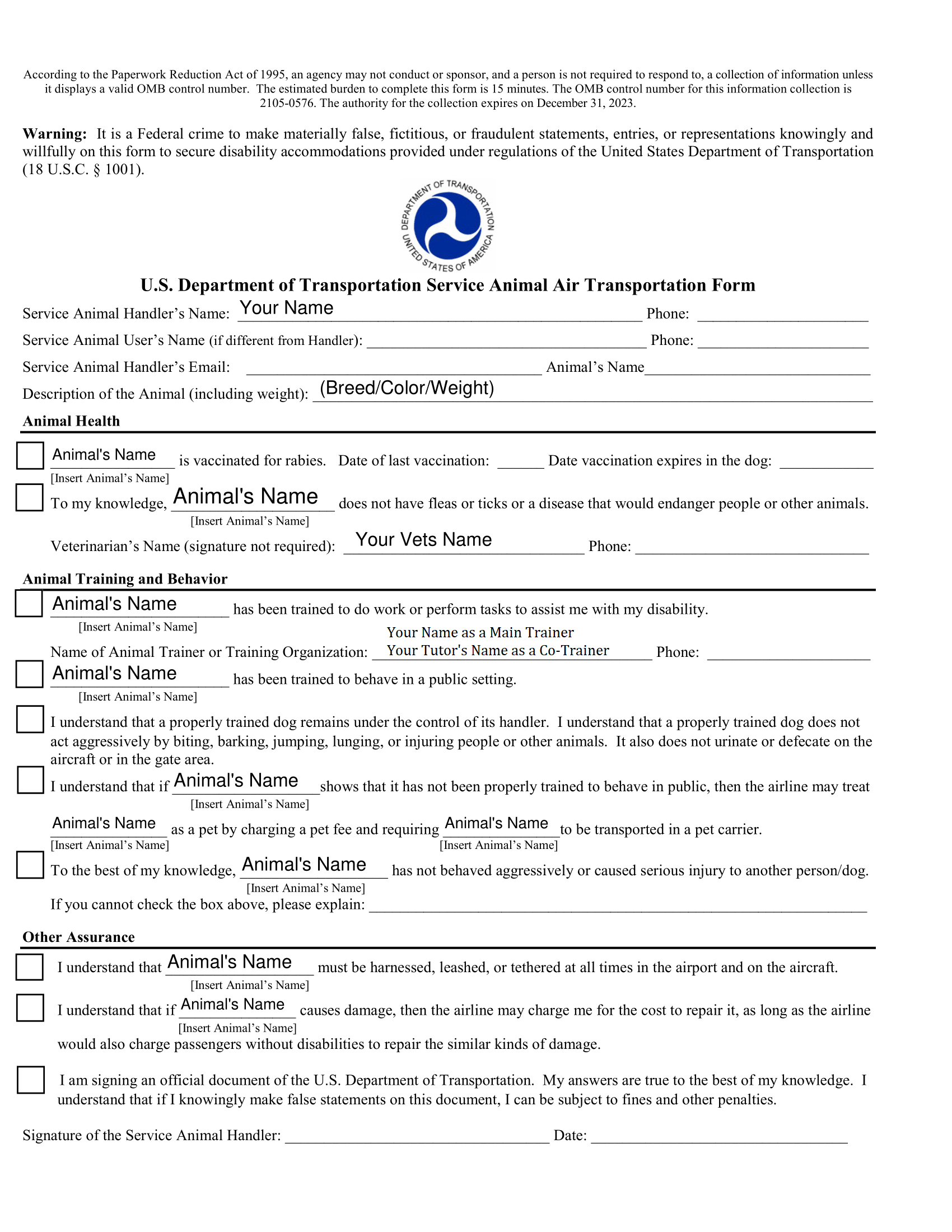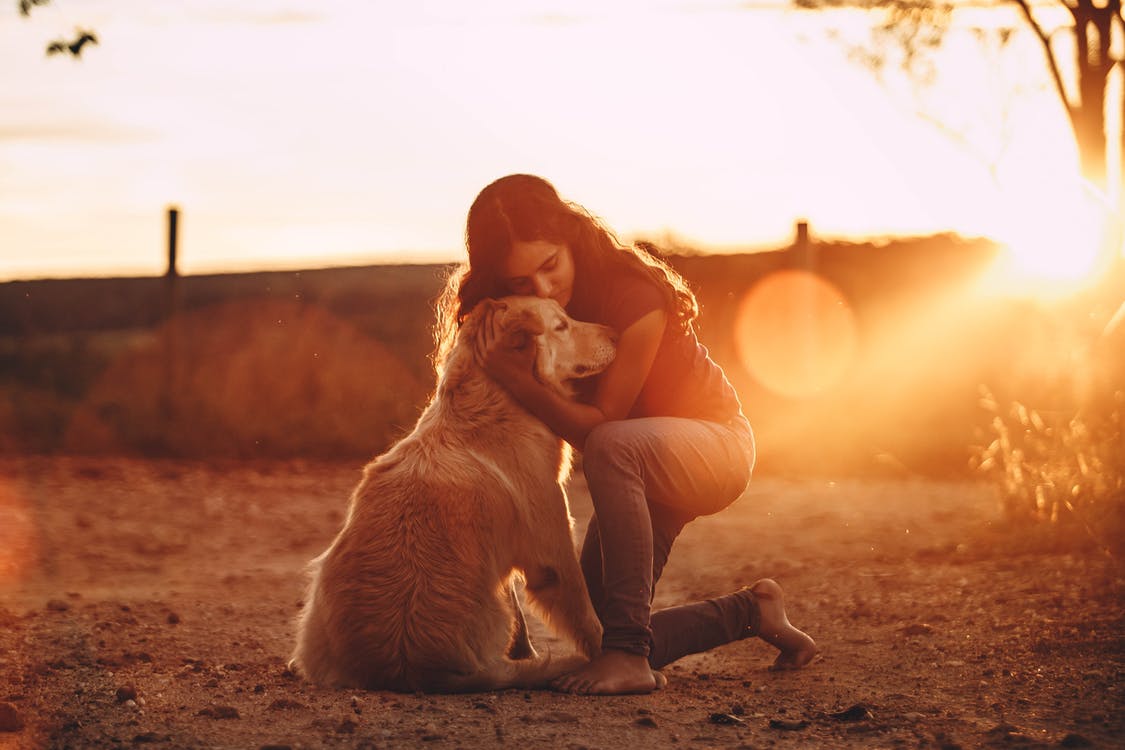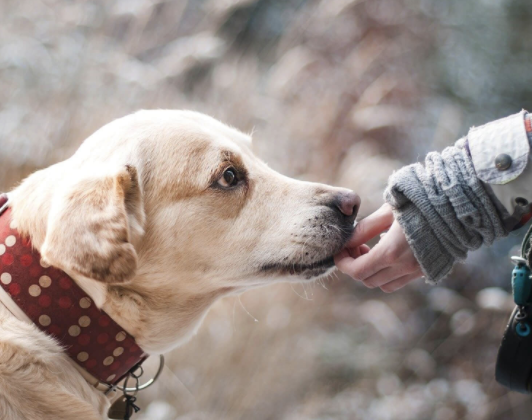- When can an Airline decline boarding to a service dog?
- What Is a Service Dog in the Eyes of the Airlines?
- Step-by-Step Guide on How to Fill Out the Form
- United States Department of Transportation Service Animal Relief Attestation Form
- Onboard the Aircraft
- Submitting the Form
- Tips for a Smooth Travel Experience

If you are reading this article, I am fairly certain that you have the US DOT form for airline transportation open in another tab in your web browser. The people who are yet to face the US DOT form and were recently informed they should submit one might want to check the sample from the government. The full name of the form reads “U.S. Department of Transportation Service Animal Air Transportation Form,” and before going into the form, you need to know a few things about the Air Carrier Access Act (ACAA) that concern service dogs. The Air Carrier Access Act in the US prohibits discrimination against persons with a physical or mental impairment that substantially limits one or more major life activities. This includes preventing service dogs from boarding flights.
When can an Airline decline boarding to a service dog?
The US DOT has made it clear that airlines can deny access to service dogs in a few cases:
1. If a service dog violates safety requirements - e.g., too large or heavy to be accommodated in the cabin;
2. If a service dog poses a direct threat to the health or safety of others;
3. Causes a significant disruption in the cabin or at airport gate areas;
4. If a service dog violates health requirements - e.g., prohibited from entering a U.S. territory or foreign country;
5. If you have not filled out the DOT form correctly - you may want to take a look at the sample above and make sure that you have filled out all the fields correctly. If you have trained your own service dog, you need to put your name as the main trainer of your dog and your tutor's name as the co-trainer. You should not type the name of the school that assisted you with the training process while going through an owner-self training program, as this information may not be accepted by airlines. Also, some airlines, may require passengers to add their flight number/boarding number to the DOT form for it to be complete;
6. If you have not submitted the DOT form in a timely manner-submitting the documentation required in a timely manner is of utmost importance for you and your service dog to be accepted in the passenger cabin.
Persons traveling with a service dog need to make sure their animal has all vaccinations required by their veterinarian. Plus, you need to make sure your dog will not cause a sanitation incident during the flight. The dog users/handlers might need to put a pet diaper or use an alternative solution to prevent the animal from relieving themselves. Travels with a service dog may be required to fill out a “U.S. Department of Transportation Service Animal Relief Attestation Form” and a sample is available online.
What Is a Service Dog in the Eyes of the Airlines?
A service dog is a specially trained dog that is trained to meet the personalized needs of its user. The service dog can be owner-trained as allowed by the Americans with Disabilities Act, but most airlines will ask for a certificate from a third party to confirm the animal has been properly trained and is safe in public spaces. The law in the US does not prohibit owner-trained animals from boarding flights, but you should keep in mind that the airline will have to abide by the laws and regulations of the destination location as well and may refuse to transport service dogs that do not meet the classification at the arrival destination. The properly trained service dogs will not initiate interactions with people or animals; they will remain calm and focused, and they respond to commands quickly. If you have a service dog and you need to travel, you should consider having the dog wear a vest that should communicate to others that the dog is trained, disciplined and is working. It should help discourage others from petting your dog without prior approval from you.
Step-by-Step Guide on How to Fill Out the Form
The first paragraph of the airline transportation form will request a few basic pieces of information, like the service dog handler's name, phone, and email address, as well as the service dog’s name, and a brief description of the dog. Keep in mind that the service dog handler and user are not always the same person, and you will need to specify that. For example, a mother and a child may travel with their service dog, where the service dog handler is the mother and the service dog user is the child. This can be applied to a married couple, too. The description of the dog should include a few key things like the dog’s weight, the dog’s breed, and the color of the coat of dog (you could add if the dog is long-haired or short-haired). If you are not sure about these details, double-check with your veterinarian in advance.
Animal Health
This paragraph will ask you to confirm the date of the rabies vaccination and when it expires. You will have to confirm that your dog does not suffer from fleas or ticks, as well as list the contact information for the dog’s veterinarian (name and phone number).
Animal Training and Behavior
This segment will be very important, and you need to enter your paw partner’s name at the start to confirm that he/she has been trained to perform tasks that assist with your disability. Depending on the training, that could include deep pressure stimulation, retrieving objects, pushing/closing drawers and doors, detecting your blood pressure, detecting your blood glucose levels, as well as pulling a wheelchair or making sure that you do not fall on the floor when you have a seizure episode.
When you move to the “Name of Animal Trainer or Training Organization” text box you might be a bit confused if you have trained the service dog yourself. Most people receive a trained dog from a school, and they can put the name of the school there along with the phone of the school. However, if your dog is owner-trained, you will need to put your name and phone number. People who have trained their pet dog to become a service dog through an owner/self-training course should put their full name and phone number as the primary trainer, as they are the ones who spent the most time (120+ hours) training their dog. In some cases, you may need to add your tutor's name, your school's name, and provide the phone number of your school.
There will be a few checkboxes for you to confirm that your dog behaves properly in public spaces and that you understand that if the dog misbehaves will be treated as a pet and can be moved to the climate-controlled cargo hold. Service dogs travel for free, but if your dog causes damage or it is moved in the cargo hold, fees will be charged. Please keep that in mind. If your dog is owner-trained, please make sure your paw partner is socialized and that they fit comfortably under the seat on your flight. The service dogs are not allotted a separate seat and will not be allowed to lie down on the aisle for safety reasons.
Other Assurance
This is the last part of the US DOT form that you need to fill out. Service dog handlers/users will need to have their dog leashed at all times and under control. You will be informed that damages caused during the flight will be expected to be paid in a matter-of-factly fashion. Please note that you are filling out an official document, and there isa lawful responsibility that you carry. Improperly filling out the form and omitting or falsifying information may lead to fines and a ban from the airline.
If you are an enrolled student of Service Dog Training School, please contact us for assistance.
United States Department of Transportation Service Animal Relief Attestation Form
As mentioned above, airlines may request the service dog handler/users to fill out and submit an additional form when traveling via their aircraft. The name of the form is pretty self-explanatory, and you will need to confirm a few things like:
Service Dog Handler Name; Service Dog User Name; Email and Phone; Animal Name; Flight Date; Departure and Arrival Location.
The airline staff may require you to indicate in writing if the dog will be wearing a diaper or an alternative solution. Some may prefer to have the dog in a kennel with absorbent pads inside.
Please, note that both forms need to be filled with the airline via email or in person at least 48 hours prior to departure. Another important piece of information you need to have is that most passenger cabins have a limit to how many service dogs they can have which is usually about 4 or 5. This needs to be cleared with your airline in advance. Some airlines offer priority boarding for persons with disabilities and you may be asked to move to a different queue at the gate so keep that in mind.
Onboard the Aircraft
The Air Carrier Access Act includes a few policies about the accessibility of facilities, namely:
⊛ New aircraft with 30 or more seats must have movable aisle armrests on half the aisle seats in the aircraft.
⊛ New twin-aisle aircraft must have accessible lavatories.
⊛ New aircraft with 100 or more seats must have priority space for storing a passenger’s folding wheelchair in the cabin.
⊛ Aircraft with more than 60 seats and an accessible lavatory must have an on-board wheelchair, regardless of when the aircraft was ordered or delivered. For flights on aircraft with more than 60 seats that do not have an accessible lavatory, airlines must place an on-board wheelchair on the flight if a passenger with a disability gives the airline 48 hours’ notice that he or she can use an inaccessible lavatory but needs an on-board wheelchair to reach the lavatory.
An animal that engages in disruptive behavior (ex. barking or snarling, running around, begging for food, and/or jumping onto other passengers) will not be accepted as a service animal unless the activity is directly related to a performed task to the benefit of the service dog user. If you believe that your rights may not have been respected by the airline, you should ask to speak with a Complaints Resolution Official (this is the person in charge of resolving disability accommodation issues). You need to allow a chance for the airline to resolve the problem and if you are not happy, you could file a complaint with the US DOT here.
Submitting the Form
Submission Methods
Airlines typically offer multiple submission methods:
1. Online Submission: Many airlines allow you to upload the completed form through their website or mobile app.
2. Email Submission: Some airlines accept the form via email. Ensure you send it to the correct email address provided by the airline.
3. In-Person Submission: You can also submit the form at the airport during check-in. However, this method is not recommended due to potential delays.
Timing
Submit the form well in advance of your travel date. Airlines generally require the form to be submitted at least 48 to 72 hours before departure. Check the specific requirements of your airline to avoid any last-minute issues.
Confirmation
After submission, confirm with the airline that they have received and approved your DOT Service Animal Air Transportation Form. Keep a copy of the form and any email confirmations for your records.
Tips for a Smooth Travel Experience
Ensure your service dog is well-prepared for the journey:
Practice Traveling: Familiarize your dog with the travel crate or carrier, if required.
Training Reinforcement: Reinforce training commands and behavior expectations leading up to the travel date.
Health Check: Schedule a veterinary check-up to ensure your dog is healthy and up-to-date on vaccinations.
Pack a travel bag for your service dog, including:
Food and Water: Sufficient food and water for the duration of the trip.
Leash and Harness: A sturdy leash and harness for controlling your dog in crowded areas.
Comfort Items: Familiar items such as a blanket or toy to help your dog feel at ease.
Cleaning Supplies: Waste bags and cleaning wipes for any accidents.
At the Airport
• Arrive Early: Give yourself plenty of time to navigate security and check-in procedures.
• Identify Relief Areas: Locate pet relief areas at the airport for your service dog to use before the flight.
• Stay Calm: Remain calm and composed, as your dog will pick up on your emotions and cues.
During the Flight
• Settle Your Dog: Help your service dog settle comfortably at your feet or in their designated space.
• Monitor Behavior: Keep an eye on your dog’s behavior and comfort throughout the flight.
• Communicate with Crew: Inform the flight attendants that you are traveling with a service dog and ask for assistance if needed.
Flying with a service dog requires careful preparation and adherence to federal and airline-specific regulations. By understanding and correctly filling out the DOT Service Animal Air Transportation Form, you can ensure a smooth and hassle-free travel experience. Remember to gather all necessary information, follow the step-by-step guide, and submit the form in a timely manner. With proper preparation and planning, you and your service dog can enjoy a safe and comfortable journey.












